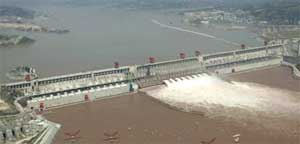 On the left, an aerial shot of the dam (image The Times)
On the left, an aerial shot of the dam (image The Times)
The Three Gorges Dam is the largest project in China since the Great Wall and the Grand Canal. The hydroelectric river dam, probably the biggest concrete construction in the world, spans the Yangtze River. The total electric generating capacity of the dam will reach 22,500 MW, at which point it will also claim the title of the largest hydro-electric power station in the world by capacity. The dam is not expected to become fully operational until about 2011.
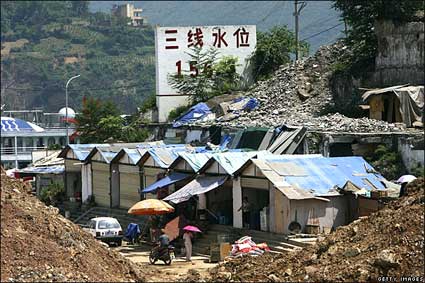 A billboard in the port of Wushan shows the height that the water will reach, ultimately submerging all of its wharf facilities (image BBC)
A billboard in the port of Wushan shows the height that the water will reach, ultimately submerging all of its wharf facilities (image BBC)
Unfortunately and despite the economic benefits such as flood control and hydroelectric power, the project also sets records for number of people displaced (at least 1.3 million), number of cities and towns flooded (13 cities, 140 towns, 1,350 villages). The 600 kilometre long reservoir will flood some 1,300 archaeological sites and the effects on the environment is quite frightening (the quality of water in the higher banks of Yangtze is falling rapidly, biodiversity is in danger, etc.)
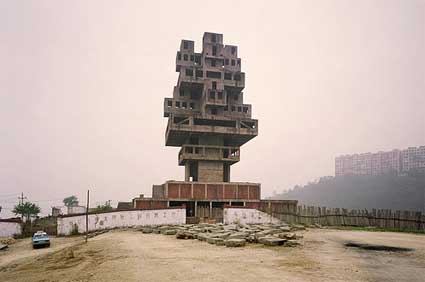 Hua Building Shot and Reverse, 2007, image courtesy of Franco Soffiantino gallery
Hua Building Shot and Reverse, 2007, image courtesy of Franco Soffiantino gallery
Flotsam Jetsam, is an art project produced by Patty Chang and David Kelley in the Three Gorges area and currently on view at the Franco Soffiantino gallery in Turin.
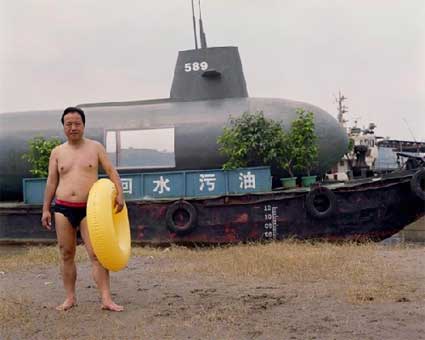 Chang & Kelley, Captain, 2007, image courtesy of the Franco Soffiantino gallery
Chang & Kelley, Captain, 2007, image courtesy of the Franco Soffiantino gallery
Upstairs is a screening of the Flotsam Jetsam video along with photographic material. Downstairs, there’s a wooden model of the submarine and Embankment, an experimental documentary created during a research trip in the Three Gorges area and which you’re invited to watch lying on water beds.
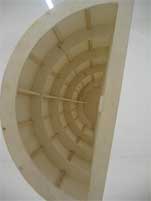
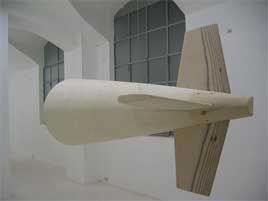 Submarine Head and Tail (Italian version)
Submarine Head and Tail (Italian version)
Very quietly and elegantly, the work engages with landscape’s relationship to identity, in the midst of the deep infrastructural changes at the Three Gorges site. The first video details the process of fabricating a submarine, launching it below the Three Gorges Dam, following the submarine’s progress along the river and through the dam’s boat locks to the reservoir. Along this journey various performances are enacted. These vernacular tales compose a third narrative regarding landscapes link to imagination. Inspired from a collection of sources including: Chairman Mao’s many swims in the Yangtze, Jules Verne’s 20,000 Leagues Under the Sea, and contemporary news’ exposés on economic development and imaginaries of the Asia ‘s modernization.
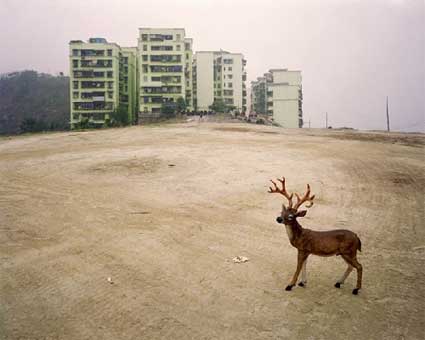 Chang & Kelley, Hua Building Shot and Reverse, 2007, image courtesy of the Franco Soffiantino gallery
Chang & Kelley, Hua Building Shot and Reverse, 2007, image courtesy of the Franco Soffiantino gallery
More images from the exhibition.
At the Franco Soffiantino gallery, Turin, until January 19.
